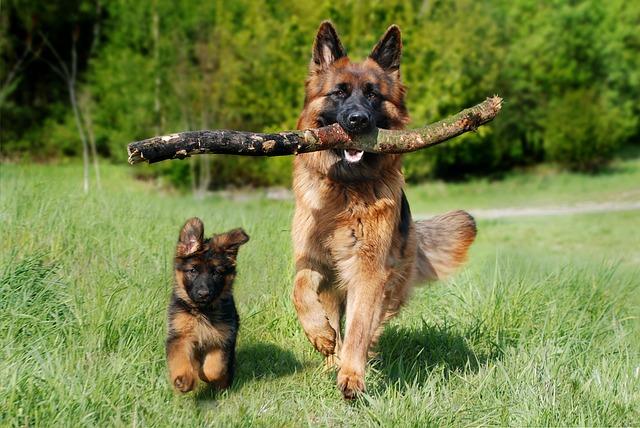Is It Safe to Let Dogs Interact With Strangers in Public

In parks and bustling city streets, the familiar sight of a wagging tail and eager paws often draws smiles and friendly greetings from passersby. Yet, beneath the surface of these seemingly innocent encounters lies a complex web of considerations. As more dog owners seek to balance their pets’ social needs with the unpredictability of public interactions, the question arises: Is it safe to let dogs interact with strangers in public? This article delves into the nuances of canine socialization, exploring the benefits and potential risks, and offers insights into making informed decisions that ensure both the safety and happiness of our four-legged companions.
Understanding Canine Social Behavior in Public Spaces
When it comes to canine interactions in public spaces, understanding their social behavior is crucial for ensuring a positive experience. Dogs, much like humans, have unique personalities and social preferences. Some dogs are naturally sociable and enjoy meeting new friends, while others may be more reserved or even anxious around unfamiliar faces. Observing your dog’s body language is key. Look for signs such as a wagging tail, relaxed posture, or an eager approach, which indicate a willingness to engage. Conversely, signs of stress like cowering, growling, or a tucked tail suggest it’s best to avoid interaction.
- Know your dog’s temperament: Is your dog friendly or shy around strangers?
- Choose the right environment: Busy areas can be overwhelming; opt for quieter spaces if your dog is anxious.
- Respect other dogs’ boundaries: Just like humans, not every dog wants to be social at all times.
- Communicate with other dog owners: A quick chat can help gauge if an interaction is appropriate.
Creating a safe environment for your dog to interact with others involves a balance of awareness and preparation. By recognizing the nuances of canine social cues and respecting individual differences, you can foster positive and safe encounters for your furry friend in public settings.

Assessing the Risks: Health and Safety Concerns for Your Dog
When considering the safety of allowing your dog to interact with strangers in public, it’s essential to weigh the potential risks and benefits. Health and safety concerns can arise from these interactions, and being proactive is key to ensuring a positive experience for both your dog and the people they meet. Dogs, much like humans, have varying temperaments, and their reactions to strangers can be unpredictable. It’s important to observe your dog’s body language and behavior during these encounters to assess their comfort level.
- Behavioral Risks: Dogs that are not well-socialized may react negatively, which could lead to aggressive behavior or anxiety.
- Health Risks: Interaction with strangers can expose your dog to parasites or illnesses, especially if the stranger’s pet is not vaccinated.
- Safety Risks: Strangers may not understand dog behavior and could inadvertently provoke a negative reaction, resulting in injury to either party.
To mitigate these risks, consider using a leash and harness to maintain control and opting for environments where your dog feels comfortable. Regular socialization and training can also help in building your dog’s confidence and improving their interactions with new people. Ultimately, being mindful of these factors will help ensure that public encounters remain safe and enjoyable for everyone involved.
Guidelines for Positive Interactions Between Dogs and Strangers
When facilitating encounters between dogs and unfamiliar people, it’s crucial to ensure a harmonious experience for everyone involved. Here are some key guidelines to consider:
- Observe Body Language: Both dogs and humans communicate a lot through body language. Look for signs of comfort or discomfort, such as a wagging tail or flattened ears, to gauge the dog’s readiness for interaction.
- Establish Boundaries: Encourage strangers to approach slowly and offer their hand for sniffing before attempting to pet the dog. This gives the dog time to adjust and feel secure.
- Use Positive Reinforcement: Reward your dog with treats or praise when they display calm and friendly behavior around strangers. This helps them associate new encounters with positive outcomes.
By following these steps, dog owners can foster positive interactions that build trust and confidence, ensuring that public encounters are safe and enjoyable for all parties.

Expert Tips for Managing Public Dog Encounters Safely
When taking your dog out in public, ensuring safe interactions with strangers is crucial for both their comfort and safety. Here are some expert tips to keep in mind:
- Assess the Situation: Before allowing your dog to approach strangers, evaluate the environment. Is it crowded or noisy? Is your dog showing signs of anxiety or stress? If so, it might be best to avoid interactions.
- Know Your Dog’s Temperament: Understanding your dog’s behavior around strangers is essential. Some dogs are naturally sociable, while others may be more reserved or fearful. Tailor your approach based on their unique personality.
- Communicate Clearly: Always inform strangers about your dog’s comfort level with interactions. A simple, “He’s friendly, but please approach slowly,” can set the tone for a positive encounter.
- Use Commands Wisely: Basic commands like “sit” or “stay” can help manage your dog’s excitement or nervousness when meeting new people.
By following these tips, you can help create a positive experience for your dog and ensure that their public interactions are enjoyable and safe for everyone involved.



